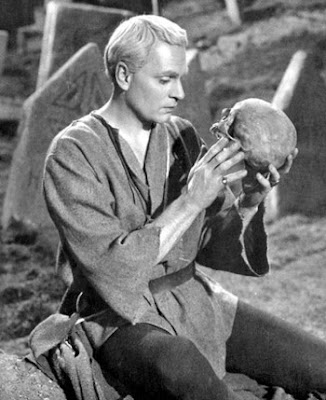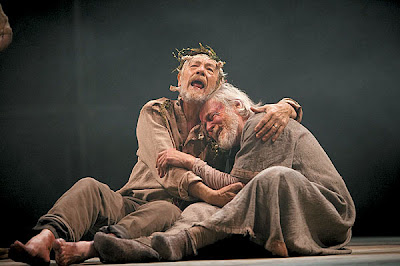Though the play invites it, the laying on of theory is not always useful to those who must act it. A couple of famous 1960s productions (Herbert
Blau’s in San Francisco, Peter Brook’s in England) took an existential tack, emphasizing the march towards nullity. But when Brook explained this approach to Paul
Scofield, his lead actor who became the most praised Lear of his generation,
Scofield replied that this might be true but it
didn’t help him. “I can’t play negative actions.” He had to be “fully active, moment after moment, even in loss, even in defeat.”
Undaunted by any of this, the Young Actors Guild of the
Northcoast Preparatory and Performing Arts Academy presented
King Lear in the Gist Theatre recently, directed by Jean
Bazemore. The audience was greeted with only a crown on the edge of Gerald Beck’s otherwise empty set, inviting us to consider kingship, which could suggest mastery of the self as well as others, and the ideal of completeness in the fullness of years. Whether Lear attains this through the coming trials is a central question.
The set remains mostly bare throughout the play, which is probably how Shakespeare’s troupe first staged it. In the choice of where they stand, the actors could use the many platform levels to express the shifting power relationships.
Bazemore also chose minimalist effects, particularly in the troublesome storm scene and the blinding of one character. The storm had some
cheesy lighting effects but I admired the sound choice: an unseen drummer on a trap set played a kind of thunder solo, punctuating Lear's ravings, sometimes emphasizing them, sometimes cutting against them. It didn't always work, but when it did it was impressively musical.
The acting style seemed modest as well: brisk and presentational, giving us the words and actions to interpret ourselves. Though probably also borne of necessity, this was a wise choice. A teenager trying to mimic the infirmities of age, for example, could easily become comic.
Instead there was emphasis on making the words clear—both their poetry and what they mean within the play. Except for some uncertain and cell phone-sounding diction, this was largely successful. Several of the actors I saw were particularly good vocally, with moments of eloquence: for example, Caleb
McIlraith as Lear, Alexander Johnson as Kent and Keenan Hilton as Edmund.
Hilton also managed to alternate obsequiousness with a sneer to give us the character of Edmund in a glance. (Maybe he’s worked in fast food?) Jules
Eubanks played the good brother Edgar with quiet assurance, while Nick
Roney portrayed his alter-ego Tom O’Bedlam with a slithery physicality. Samantha
Biasca was instantly sympathetic as Cordelia, and in their better moments
Navarra Carr trembled with rage as the bad
Goneril while Hayley Connors-Keith was an insinuatingly evil Regan. Jesse
Drucker as
Glouchester, Izzy
Samuels as Albany,
Keli Rael Floyd as the Fool, Evan
Mahoney-
Moyer as Cornwall and Patrick Roberts as Oswald acquitted themselves well.
The other actors I saw included
Dawut Sassanapitax, Nicholas
Mundy, Elena Hernandez,
Shantal Polit, Gisela
Bueno, Galina
Schroder, Serena
Sprater,
Vasin Pasda, and
Yagmur Khan. Many major roles were double-cast, so I
didn’t see Sylvan
Arevalo as Lear, or Miriam Cook, Kaylee
Wennerholm,
Genay Pilarowski, Rachel
Scherer, Rosie O’Leary, Reed Benoit, Camden
Bruner, Aimee
Talmadge and Zoe Huber. Chris
Sutter and Kaela
Sutter designed excellent costumes.
Of the many themes and elements of this capacious play, I thought in watching this production not only of the personal journey of age but a societal journey of the moment, from the sheltered wealth of Lear’s court to his mad stumble through the storm of loss and naked need, eventually warmed by the brief candle of compassion.
The quality of
Northcoast Prep productions often make you forget that these are high school students. This
wasn’t always the case with
King Lear, but the beauty of an
un-
actable play (as
Shakespearean actor and
Slings and Arrows star Paul Gross points out) is the freedom to try things when failure is inevitable. And some of the beauty of Shakespeare involves the worlds his plays open up to participants and audience alike, redefining the perfect production that can never be attained.
I suppose my own perfect production would begin with distant thunder, and the conversation among Kent,
Glouchester and Edmund just outside the castle--out of the wind but not entirely inside. The throne room however would be bright and warm, with all the comforts--food and fire, well-clothed courtiers.
Lear's daughters, Regan and
Goneril would be particularly well-dressed, in a provocative, almost
lascivious way. Their dialogue with Lear--their flattering professions of love-- would involve physical touching. I imagine Lear as having little to do with his daughters beyond these court displays, except perhaps for Cordelia. I think I buy the idea that part of what's going on in this scene is Lear trying to marry Cordelia off.
In any case I would emphasize the comfort of the court and the shelter of the entitled King. I can see his desire to retire and "put off care" as reaching for more comfort as well as enjoying the honor of his reign. He might see retirement as endless feasts and hunting expeditions with his knights, interspersed with testimonial dinners--if that's not too modern an idea of retirement. Cordelia and Kent
mar his picture of a perfect retirement and are banished.
Things change, when he realizes his powerlessness, and he becomes an exile and outcast. He loses his life's security and literally he loses his shelter. At this point I can see Lear not as suffering from a disease or even becoming infirm--he seems feisty enough throughout. But he is dealing with
humiliation and limitation, which is part of what aging is about. He goes in and out of madness, and the wisdom he is acquiring is at first the dislocated wisdom of the fool (the Fool) and the lowest of the outcasts (Tom.) His journey is mirrored in its way by
Glouchester, as he begins to see realities he missed before he was blind: that revisiting of the worst of the past, particularly regrets and their causes, is another familiar aspect of aging, at least for men.
What happens when security is gone--including the world order you felt entitled to--right down to your shelter: that's a theme for today. That Lear reaches certain insights and perhaps wisdom, and yet there is no immediate happy ending--this too is the natural course of aging, since it ends in only one way. The unsettled state of the state at the end of the play also may remind us that transformation doesn't always lead instantly to happily ever after. Maybe it takes a younger generation, learning enough from the hard-earned insights of the older not to make all the same mistakes.
































